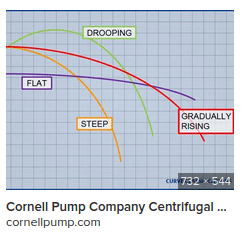Hello Muthu
Yes, VFDs can be used on turbine and positive displacement pumps, but you must use them correctly and for the right reason.
If you consider a standard centrifugal pump, then varying the speed of the impellor is essentially the same as varying the diameter of the impellor and there is a set of performance curves head against flow for different impellor diameters or different impellor speeds.
On steep curve pumps, the discharge head varies with flow. By varying the speed, we can compensate for flow variation and keep the discharge pressure constant. If we do this using a valve, then we will have a pressure drop across the valve and a flow through it, so we have a KW loss across the valve. Reducing the speed to reduce the pressure removes the energy loss across the valve, but does replace it with energy loss in the VFD and the harmonic mitigation where fitted. This would be a primary selling feature of a VFD on centrifugal pumps, but if the pump is a correctly engineered flat curve pump, then the speed will be almost constant and the VFD just increases the losses.
Where a centrifugal pump is not engineered correctly and is too large for the application, then the VFD can be used to electronically adjust the size of the pump by setting a different speed.
The VFD can also be used to limit the flow when the discharge pipe is empty and folding the speed down until the pipe is full and fully pressurised is another advantage of a VFD. This can also be achieved by the use of a control valve.
In the case of a turbine pump, a VFD can be used with a fast ramp, to ramp the pump up from zero to full speed provided that the pump does not become hydraulically stalled. This will reduce the start current. Once at full speed and the line is full, then the VFD can be bypassed (requires a special VFD that can be synchronously bypassed) or the VFD can continue to run at full speed. If the pump is too large, it may be able to be slowed by a small amount to reduce the flow, but must not drop the speed to a level where the discharge pressure is insufficient to maintain flow.
In the case where the pump is pumping over a flood wall with the pipe exit well below the top of the flood wall, then syphoning may reduce the effective head pressure requirment and the drive could slow the pump by a greater amount.
I have seen an instance of a 400KW correctly engineered turbine flood pump controlled by a soft starter was replaced by a larger pump and VFD to save energy, but the VFD could not start the pump due to the pump hydraulicaly stalling and severely overloading the VFD.
Centrifugal pumps and turbine pumps behave very differently and some multi stage centrifugal exhibit characteristicss that fall between the two.
Mark Empson
Advanced Motor Control Ltd
